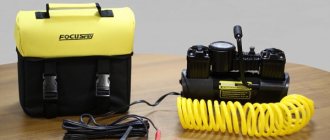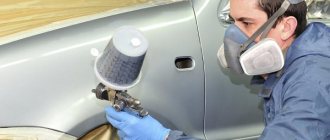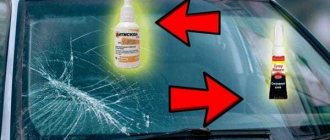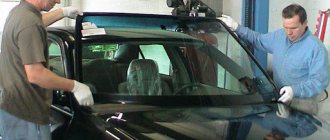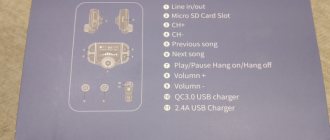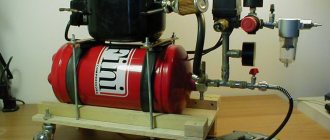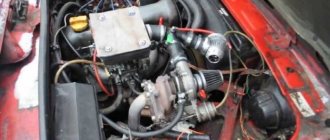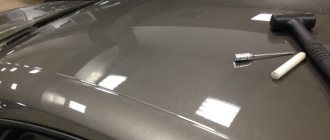Even the most disciplined car owner is not protected from damage to the paintwork of his car. And if for beginners, the flawless appearance of the car usually comes first, then experienced drivers know well that if they leave a scratched area untreated, the corrosion virus will take over, which can spread over a fairly large area in a short time. Therefore, bringing the paintwork back to normal is an activity that it is advisable to carry out as early as possible.
Compressor FIAC AB 100-360
In this regard, there are several available options for solving the problem - contact a car service, which will cost a lot of money, use a “garage” level service - this is cheaper, but not as high quality. Finally, you can touch up the body parts yourself. In this case, you will have to spend money on purchasing the appropriate equipment, but if you take into account that you will have to paint for almost the entire life of the car, then this method can ultimately be called the most preferable. The main problem that will have to be solved when purchasing such equipment is what kind of compressor is needed to paint a car, since the modern market is literally overflowing with models of different designs and performance. This material will be devoted to covering precisely this issue.
Purpose of automobile compressors
For any spray gun, the main component is a compressor - a device that ensures the injection of air or other working gas mixture under pressure, which is necessary for high-quality spraying of paints and varnishes. We all remember Soviet vacuum cleaners, which sucked up dust on one side and pumped air on the other and were used as a source of compressed air for spray guns. Modern compressors have a much higher efficiency; they are more powerful, efficient, and more reliable. However, there are a huge number of their varieties, which makes the task of choosing a compressor for painting a car non-trivial, requiring knowledge of their design features and the main criteria that affect the performance and cost of the device.
In general, car painting is not the only area where compressor units are used in car maintenance and repair. The range of problems solved with their help is extensive:
- working with tools that use a pneumatic drive (wrenches, devices for inflating tires);
- applying a layer of primer (pre-treatment of car surfaces);
- means for applying anti-corrosion solutions;
- cleaning/purging of contaminated parts, components and assemblies;
- washing/polishing.
There are three classes of devices depending on their intensity of use and degree of load.
What kind of compressor is needed to paint a car?
A compressor unit for uniform painting is a must-have device; with its help, the owner can paint the car independently. It is difficult for an inexperienced buyer to choose the best device, which raises questions about how to choose a compressor for painting. There are several basic installation characteristics on which the choice is based.
Criteria for selecting compressor models for car painting
To determine which compressor is needed for painting a car in a particular case, it is necessary to consider the purpose of the device:
- for cosmetic restoration. This compressor for painting a car will help you gain painting skills. It is preferred due to its low price and the ability to process individual body parts. It is recommended to pay attention to the presence of an oil-type piston, a single-cylinder version with a minimum efficiency of 130 l/minute. Reverse turns out to be useful, preferably with a power of 25 hp. Pressure at 8–10 bar. With its help it will not be possible to restore the entire car, but for individual elements the power is quite enough;
- with air compression function. An air compressor for painting requires some skills, at least minimal (painting 1 or more automotive elements before). It is recommended to prefer a model with 1 cylinder and an oil lubrication system. It is preferable to have a 100 l receiver and a pressure of about 10 bar, which is enough to release 330 l/m. The result of the work is of higher quality, but it still limits the user. Complete painting will become difficult, since the device does not take in the required amount of air;
- for high-quality and complete coloring. Most often, such belt compressors with high performance, about 515 l/m, are preferred. The receiver is designed for 200 liters and pressure up to 10 atmospheres. A long period of operation allows you to paint different areas of the working surface. The only downside is the significant increase in price compared to the models discussed above;
- professional device. If the primary task when choosing is professional activity, you should buy more reliable and high-quality models. The best option is a screw type with low power, in the range of 250–620 l/m, and a pressure of 10 atm. The models are reliable, provide economical consumption, and can operate for a long time. The price is slightly higher, but the installation quickly pays for itself.
A compressor is needed to paint a car.
Taking into account the goal, it becomes easier to figure out which compressor to choose for painting a car. The assortment of stores has options for every task and pocket.
Selection principles
To thoroughly select a suitable device, always take into account:
- installation power;
- pressure;
- performance;
- receiver capacity;
- work resource.
Compressor for car painting “Metabo”
Options for domestic use have degraded characteristics, but their price is low. The best performance indicators are typical for professional installations, but you will have to pay a considerable amount for them, which will pay off after several orders.
Many people buy an air-type painting compressor, which is more suitable for one-time jobs. It’s better to pay a little extra and buy a universal variety that will be useful in the future for other tasks.
Performance characteristics
Recommendations for selection:
- power. The choice should be based on the indicators of the compatible installation. A pneumatic tool has special parameters; the compressor must at least provide the maximum power of the spray gun. In domestic conditions, it is optimal to use options with a power of 1.5 kW. Manufacturers often indicate characteristics in horsepower (hp), then you should select the option with 2 hp. As the indicator increases, the pressure build-up accelerates;
- pressure. The vast majority produce 8–12 bar. It is customary to indicate the maximum pressure; it is developed only in the receiver, and the performance indicators are always 2 bar lower;
- performance. The indicator is divided into 2 groups: at reception and at delivery. The productivity at the fence is indicated in the technical documentation, and the actual parameter is calculated manually. To determine a suitable option, consider the ratio of the air flow of the pneumatic tool and the compressor;
- receiver volume. Preferably – from 50 l;
- nutrition. Operates from a 220 V or 380 V network; there are also models with universal connection. Professional options operate from 380 V, and therefore require the installation of 3-phase wiring.
Compressor for painting “Hyundai”
Performance is a key parameter; to make the calculation more certain, it is worth using the device parameters:
- The spray gun operates with a pressure of 3–4 atm., the device consumes 200–400 l/min. The Ki utilization rate is 0.65;
- for grinding devices, the pressure reaches 6.2 bar and the flow rate is 350–450 l/min. Ki – 0.65;
- in blow guns the output is 4–6 bar, uses 150–250 l/min, and Ki is 0.3.
Additional parameters will help you determine which compressor is needed for painting a car:
- protection. Designated as an index of letters and numbers. It displays the degree of protection of the electrical system in the device. Reflects the risk of current flow in the event of damage by objects, clogging or flooding of the compressor;
- temperature range. Indicates recommended operating conditions that guarantee serviceability and compliance with the stated characteristics;
- maximum pressure. If the indicator is high, you can connect other devices to the device. Painting requires 3–4 atm;
- engine speed.
The auxiliary characteristics of the compressor for car painting do not affect the quality of the paintwork, but provide versatility, comfort and durability of the installation.
Oil-free compressor Remeza SB4-100.OLD15T
Types of construction
An alternative way to choose a compressor for painting a car is based on the type of design. Models are classified by:
- lubrication system - with or without oil;
- drive design - direct or belt;
- number of pressure levels – 1-, 2- or multi-stage;
- compression method - piston, membrane.
Oil-free
Car painting is most often done using oil-free types of installations. They are actively used for painting work with a minimum amount of oil in the paint composition (up to 0.01 mg/m3). A variety of devices improves the quality of painting and creates an ideal appearance. An adsorption type dryer is installed in the design.
They are distinguished by their reliability, ease of use and operation. Disadvantages: Few features and subject to wear and tear.
Oily
The system provides for spraying of lubricant by the compressor unit. This variety is characterized by oil getting into the paint; it is poured into the pump. Filters are installed to prevent liquids from mixing.
Coaxial oil compressor KAC 50L
The mixture helps create a film that protects against contact between metal products. Oil reduces wear and heat generation. Performance does not suffer from this solution.
The main disadvantage is the difficulty of starting in cold weather. Oil varieties are further divided into 2 groups: direct and belt drive.
Direct drive (coaxial)
A coupling is used to connect the engine and the crank; it combines both parts into a solid structure. The models are simple and compact, but heat dissipation deteriorates.
Belt driven
A compressor for car painting, most often it is designed according to a standard design - a belt connects the motor shaft and the pulley. It has high-quality cooling, increased performance, minimal noise and durability. In turn, belt types have several categories according to compression stages: 1, 2 and more.
Piston
This type provides the required level of spray quality while maintaining simplicity and reliability. The crankshaft and connecting rod are used to activate the piston. The pressure generated causes the intake and exhaust valves to close or open. The design can install 1-2 cylinders with a linear, W- and V-shaped arrangement. More often, the desired result is achieved by 2-stage compression.
Piston compressor KCTD 420-100
Screw
Before the paint reaches the spray gun, several rotors rotate in the compressor in a parallel arrangement. During movement, cells are formed, they decrease in size and increase pressure. The design includes a standard protection, control and condition monitoring system. Interaction with the electrical installation is simple; mode switching is done with one hand. The screw type is able to work for a long time without overheating.
Pros:
- minimal energy consumption;
- silent operation;
- does not create vibrations;
- high-quality outlet air;
- reliable device;
- wear resistance.
Most often used in professional, large service stations.
Membrane
The cheapest and weakest type of tool, used in domestic conditions. Characterized by moderate performance and high pressure.
Automotive diaphragm compressor
Performance
Is a key factor when choosing. Regardless of whether air or airless type is chosen, air compression directly affects the quality of atomization. The measurement is based on the ability to compress air in 1 minute, determined in liters. The air consumption for applying the same amount of paint varies significantly among different spray guns.
Pressure
Depending on the model, the maximum in receivers is 8–12 atm. When the threshold is reached, the installation is switched off. Switching on occurs when the pressure drops to 6 atm, the unit operates until the operating indicator is restored. The user sets the activation threshold independently. To protect against overheating, it is recommended to buy models with a thermal relay.
Power supply
With every 1 bar increase in pressure, the installation will have to use 8% more energy resources. The reason is the loss of compression ratio during operation. To save energy, it is recommended to accurately determine the power and operate the air sprayer in this mode.
Abac screw compressor
Correct performance calculation
Performance shown is not a reflection of actual performance. The suction characteristics are indicated on the packaging, and the output figure will be 20–25% less. It is recommended to select the performance of the pneumatic tool with a margin (there are significant deviations in air flow) of approximately 5–10%.
How to use it correctly
It is possible to paint a car well only if the conditions of use are met, since if handled ineptly, even a high-quality installation will not give a positive result or will quickly wear out.
Recommendations:
- the installation must be turned on and off periodically, otherwise they conclude that the compressor power is insufficient;
- during cold periods, the crankcase is heated with a hairdryer to fill the oil;
- regular filter replacement;
- periodic cleaning of the device. At a minimum, it should be performed once every six months.
Expert advice
When choosing, you should focus on a few basic tips:
- It is irrational to buy a professional device for a one-time job. The choice is made based on the task;
- pay attention to the required voltage in the network;
- reviews and brand reputation will help you buy a durable device;
- high performance and power indicators will help to use the compressor with other devices;
- it is better to buy an option with a desiccant, it prevents moisture from penetrating into the solution;
- Water accumulates in the receiver; it should be drained once a week to prevent corrosion;
- the air filter is regularly washed and blown, simply replaced if necessary;
- Before turning on, check the oil level. If there is a deficiency, add it, periodically drain the oil completely and change it;
- the bolts on the cylinder head, the condition of the belt, bearings and engine are checked once every 4 months;
- Belt tension is performed once every 200 hours of operation.
The compressor quickly pays for itself in both domestic and specialized environments. There is no point in saving too much on it. Technical specifications, determining the appropriate type and using tips will help you make the right choice.
Sources: https://mensdrive.ru/instrumenty-i-materialy/kompressor-dlja-pokraski-avtomobilja https://instrumentoria.ru/62-kak-rabotaet-kraskopult.html
Compressors for rare applications
Affordable, but not intended for long-term use, the devices are the choice of those who paint body parts relatively rarely. What kind of compressor is needed to paint a car in a garage? The answer is quite simple: devices that provide productivity in the range of 125 - 250 liters per minute. The specific value depends on the model of the spray gun, or rather, on its ability to consume the maximum volume of air. In this case, the operating pressure of the compressor should not exceed 10 atmospheres, and the power should be within the range of 1500 - 3000 W. Such devices can operate for 15–20 minutes/hour. But even a low-power device must contain a filter to clean the incoming air from various impurities contained in it, primarily from dust and oils: when painting, the purity of the air used is a critical indicator for the quality of paint application. It would also be useful to have a refrigerated dryer used to clean the air flow from water vapor that is present in any compressed gases.
Compressor parameters and characteristics
- Performance. This is the volume of compressed air per minute. It is measured in liters per minute (l/min). First of all, you need to pay attention to the volumetric performance of the compressor. This is the most important parameter. Each pneumatic tool has specific air volume requirements to operate. Manufacturers of piston compressors most often indicate theoretical suction capacity. The actual output output, which is what is needed for the spray gun to operate, may differ by 25–30%, depending on the operating pressure used. In addition, the compressor capacity should be 15–20% higher than the expected air flow rate so that the compressor does not overheat during operation. If the output capacity coincides with the demand of the spray gun, then you need to monitor the work and rest cycle of the compressor. After 3-4 minutes of operation, you will need to pause for 3 minutes to allow the compressor to cool down.
- Pressure – Every pneumatic tool requires a certain amount of pressure to operate. Modern HVLP spray guns operate at low pressure, which is reflected by their very name (HVLP - High Volume Low Pressure, high volume at low pressure). 2-3 atmospheres will be enough, which can be easily provided by any compressor. What is more important is the large volume of compressed air, which was mentioned in the previous paragraph. Pneumatic tools require 6–7 atmospheres, which is also not a problem.
Semi-professional compressors
For medium-intensity painting work, the optimal device would be a piston-type belt oil compressor. When choosing it, you should take into account such factors as the daily volume of work, as well as whether you intend to use other tools with a pneumatic drive (a grinder, for example, consumes a fairly large volume of air - about 500 - 600 liters per minute). The general rule is this: the compressor performance should exceed the needs of the spray gun by about one and a half times. Thus, if the technical characteristics of a paint sprayer are consumption of about 300 liters of air per minute, then a compressor with a capacity of 450 - 600 liters per minute is required. A certain reserve of power is also necessary, since in this case longer operation of the device is ensured without frequent interruptions. Finally, the volume of air that the spray gun can manage depends on the volume of the receiver. When carrying out painting work, ensuring non-stop spraying of paintwork materials is a guarantee that the paint or varnish will not begin to set even before it hits the surface to be painted. In the latter case, painting defects in the form of sagging and omissions are inevitable.
Summarizing the above, we can recommend for painting work in a small workshop a compressor with a capacity of about 600 liters per minute, with a working pressure of about 16 bar with a receiver volume of 50 - 100 liters. With such equipment it is possible to paint both individual body parts and the entire car. Household compressors with a receiver capacity of 40 - 50 liters and a capacity of up to 250 liters per minute will clearly not be enough to perform high-quality painting work with relatively frequent use. You should pay attention to the compliance of the quality of electrical wiring with the power of the compressor - for 10 - 15 kW, weak wiring is a source of increased danger.
Semi-professional compressor QUATTRO ELEMENTI KM 50-380
How to choose a compressor for car painting
Author: Sergey Khilik
expert in the “Construction Equipment” category
A compressor for painting a car is a guarantee that the painting will be done at the highest level. It helps to carry out this process easily and without problems, that is, with a correctly applied layer of paint and an evenly sprayed paint coating.
Each compressor operates on the principle of a pump, only it supplies air, not liquid. Air compressed under pressure is accumulated in the receiver, and from there, through connectors, is supplied to the spray gun.
Types of compressors and their comparison
Before choosing a compressor for painting, I recommend that you decide for what purpose and what type of painting you need it for. Different types of painting require different technical parameters, which are determined by the class of the device.
Among the huge variety of compressors that are on the market today and available for purchase and use in garages and professional service stations, there are three main types:
1. Household (garage) compressors. These are relatively cheap units, piston and single-cylinder with a 20-25 liter receiver. They are great for small painting and blowing jobs. On average, the air flow in such devices is 130 l/m. You cannot connect professional pneumatic equipment to them, but it is quite possible to leisurely paint a gate, fence or small parts. They can also be used effectively when working with airbrushes, where the compressor requires more constant pressure for even application of parts. 2. Semi-professional units. These are reliable and expensive units that can be used to perform more serious tasks. There are two types here:
- Piston with a 50 liter receiver, direct drive or two-cylinder, the average air flow rate of which ranges from 200 to 330 l/m and has a pressure of 8 atmospheres;
- Piston with a 100-liter receiver, single-cylinder with a belt drive, picks up a speed of 330 l/m or more, the pressure mark is kept within 10 atmospheres.
I recommend using such units both in the home garage and for large-scale work. Without interruption, you can paint the entire side of the car. But such devices can also overheat. If overloaded or operated for a long time, the piston compressor for car painting can become very hot, which will lead to inevitable breakdown. The first type overheats due to the fact that it has a direct engine drive, and the second, having an improved design, namely a belt drive, is equipped with one piston with an aluminum head, which also leads to overheating and failure during prolonged operation.
3. Professional units. The most expensive and reliable units with thoughtful technological features. These are piston units with a receiver of 200 liters or more, with a belt drive, cast iron engine heads, built-in filters for trapping oil and moisture and an overheating protection system. The air flow in such devices can be even more than 1300 l/m, and the pressure is 10-16 atmospheres. These compressors easily cope not only with painting a passenger car, but also a truck, and also enable several people to work. They are virtually immune to overload, which makes them ideal devices for professional painters.
Basic parameters required for painting
For high-quality painting of a car, it is necessary that the compressor have certain operating parameters. The main technical characteristics are air flow, its pressure, the volume of the receiver (the larger, the longer the operation without interruption) and, accordingly, the engine power and the phase pattern of the motor itself.
In order to bring the car to almost new condition (paint it perfectly), I recommend choosing a compressor with the following technical indicators:
- The receiver volume ranges from 100 to 270 liters (depending on technical features and purpose). I note that small compressors with a 25-liter receiver may be suitable for occasional painting in a home garage;
- Productivity – from 200 to 500 l/m and above. 200-300 l/min for home, 500 l/min and more for service stations;
- Pressure - this parameter is adjusted on each compressor. If you don’t need 10 atmospheres, you can freely reduce it to 5.4 or even 2 depending on the work, the parts being processed or the spray guns you use.
How important is the type of compressor drive and how does it affect its operation?
Choosing a compressor for painting a car is impossible without studying the features of the compressor drive. Modern units use 4 types of drives, but the most popular are:
With direct drive, torque is directly transmitted to the crankshaft of the air-injecting part of the device. In another case, with a belt drive type, the torque is redirected from the drive pulley to the driven pulley using a belt.
Since the drive design is different, their role in improving operating parameters is also different. Professionals recommend using models with a belt drive, although they are more expensive.
Here are the main advantages of such units:
- High speeds, thanks to the direct transmission of torque - about 2800 rpm;
- Belt units are more resistant to overheating during long-term operation, since the design has a large number of radiator sections to cool the air;
- The smaller diameter of the crankshaft drive pulley in the belt type of drive makes it easier to start the engine;
- And two- or more-cylinder engines are made of cast iron, which improves heat transfer and increases their service life and ability to withstand high temperatures.
That is, you work with a belt compressor for a long time, there is no overheating, and its resource is incomparably longer.
For household work, it is quite possible to buy devices with direct drive. Not only are they cheaper, they are also more compact in size. And repairing them is much simpler and inexpensive. But don’t expect durability from such a device, nor the ability to work for a long time.
What is the most important parameter of a painting compressor: air flow or pressure?
How to choose a compressor for painting to achieve the best result and what parameters should you pay attention to?
It is believed that the compressor pressure determines its class: the higher it is, the better the unit. I guess, yes. Although there are pitfalls here too, not every compressor has a constant, high pressure, only more expensive models of equipment from well-known brands can boast of this, and this is an expensive purchase and not everyone can afford it, and the average recommended pressure in a pneumatic tool is 6-8 atmospheres , so you don’t always need to chase this parameter. But if your air supply system in a paint shop is designed for several connections, this parameter is considered a priority.
Our recommendation is to pay more attention to the air flow rate. Here's why: compressed air determines the performance of the compressor. It is he who puts the mechanism into operation. For this reason, the amount of compressed air and its consumption plays a special role when choosing pneumatic tools and vice versa. Air tools have no such thing as power. It is called air flow and is indicated in the data sheet. That is, the same paint sprayer may require 150 liters of compressed air, or maybe all 400. If you connect a compressor with a capacity of 200 liters per minute to the second option, then there is no point in starting work - there will be no painting, and the device itself can quickly fail out of service
The most common problems with compressors
An air compressor for painting, like any other equipment, can break down. Sometimes this happens due to electrical problems, sometimes due to factory design defects, due to overloads and overheating of the mechanism during operation, etc.
I will tell you two main problems. One of them concerns incorrectly selected pneumatics. The other occurs partly for the same reason, and partly due to factors that you are not even aware of.
The first is a breakdown due to an incorrectly selected high-flow gun
All paint spray guns are divided into three groups:
- With HP high pressure technology. Guns of this type require a pressure of 8-10 bar, but their air consumption is low. Such devices are considered obsolete, since due to the high pressure there is a large loss of paint. But any compressors are suitable for them, even with low performance.
- Guns using the HVLP system. This technology uses increased air flow.
- With LVLP technology. This means: “a little pressure - a little air.” The most versatile, as even a low-power compressor will satisfy them.
Problems arise when connecting a gun that has HVLP technology, which requires a lot of air. This technology is the most common, as painting efficiency increases to 90-95%. But the air flow rate is a trap that many inexperienced users fall into. Be sure to read the air requirement on the gun. If it is 200 liters per minute, then the compressor must be selected with a capacity of at least 200, plus a reserve of 30-40%. That is, the air blower should have a performance indicator of 250-300 liters per minute. Then he can easily pull out such a pistol.
If you missed such an important number, then when connected, the following happens: in order to supply a lot of air (to the maximum or even more), the compressor is constantly turned on, because the pressure in the receiver is constantly dropping. Your device tries to pump in the required amount of air, working for wear. It turns out that the engine runs constantly, but the outlet pressure still “floats”. You begin to stop work, pump up the pressure. And in vain. All the same, the required air flow will not be achieved, since the compressor simply cannot provide the required performance. But the engine is running at its limit. It’s good if the automation turns it off, but if not, terrible wear of the piston group occurs, and ultimately the mechanism breaks down.
The solution to the problem is to choose another gun with a suitable air flow. If a breakdown occurs, replace the pistons, although this is a completely unnecessary waste of money. They could have been avoided if you carefully looked at and compared two indicators before purchasing:
- compressor performance;
- gun air consumption.
Ideally, the first should be 30-40% larger than the second.
The second reason is overheating of the compressor itself.
By overheating of the compressor, I mean overheating of the windings of its electric motor. Again, if there is a thermal relay, this is very good. It will turn off the mechanism on its own, and the unit simply will not work. But if the situation repeats again and again, then the relay itself will become unusable, then the working windings will burn, become soldered and break. The engine needs repair - either a new motor, or a new winding of the rotor and stator. Therefore, you definitely need to find out why overheating occurs. There may be several reasons:
- The most obvious is that the power of your device is not enough to compensate for the load. This situation arises, as I already described above, when connecting incorrectly selected pneumatics (with a high air flow rate);
- Insufficient cooling. Inspect the cooling system. It is usually airy. There is a natural one - thanks to the stiffening ribs on the cylinder heads, there is a forced one with a fan. The second is much more effective, but the impeller can jam if it is not lubricated or clogged with dust and dirt. Lubricate, clean or blow off dust from the compressor itself after use.
- There is not enough oil in the engine. The rubbing parts (piston pair) feel increased resistance and begin to heat up. Cooling cannot cope with the situation. The solution is simple - carefully monitor the oil level. But if you overfill the recommended level, it can create the following problem;
- Too much oil - the pistons operate in an excessively viscous environment. This can also cause them to heat up;
- Poor mains voltage. The supply voltage is much higher than the norm (the norm is 220 Volts, deviations of 10% are allowed, but no more). Measure the voltage at the outlet. If more than 240 Volts, install a voltage stabilizer.
The main mistakes a buyer makes when purchasing a compressor
In order to choose the right compressor and not make a mistake, you need to study the technical documentation and decide on the final purpose of such a unit. The main miscalculation when choosing a compressor is that in most cases the buyer incorrectly evaluates the technical characteristics of the device and their compliance with the intended operation. If you are not sure about something, it is better to ask professional consultants or consult with those people who are actively involved in painting. Problems also often arise with the incorrect selection of pneumatic tools. As I already explained above, do not try to chase high pressure, because this is not the most important parameter for which you need to buy a compressor, only all the parameters together will give effective operation.
Let's summarize - if you are not going to do large-scale painting, but will mainly inflate wheels, paint some small details, or blow out small parts, choose small compressors with small receivers, they just belong in the garage. Service stations often need a large volume of receiver, a powerful engine, preferably a two-piston one, then your work will be successful and customers will be satisfied with the quality.
And finally, I repeat once again - the efficiency of the model depends on the number of pistons. But it is worth noting that their volume and material also play an important role. The best compressor is one with a cast iron cylinder, so look for just one, and don’t try to take a worse quality, but two-cylinder one.
Professional compressors
There are always increased demands placed on professional-grade tools and equipment. Compressed air supply devices used to operate painting equipment are no exception. When buying a compressor for car painting, it is better not to focus on the cost, since it depends on many factors that are not always related to the performance and reliability of the device, as well as the quality of the work performed. The ones that best meet the requirements of professional use are piston-type compressors equipped with an air dryer (this is the de facto standard for compressors of any level if increased demands are placed on the quality of the applied paint layer).
Good results can also be achieved using screw devices characterized by medium power. Such compressors are characterized by acceptable quality of output air flow (low moisture and oil content), high reliability and an acceptable level of energy consumption, they are easy to maintain and have a more compact size compared to piston analogues. If production conditions require a lack of free space, screw compressors will come in handy. For service stations or companies specializing in car painting, compressor units are recommended, which are mini-stations with a power of about 2.5 - 5.5 kW, with a receiver volume of up to 900 liters and a capacity of up to 600 liters per minute. The complete set of such installations includes a system of compressor filters and dryers operating on the refrigeration principle.
Types of compressors
A huge range of air compression devices can create problems when choosing a compressor for painting a car, even for a specialist, not to mention those who are faced with this for the first time. This is not surprising, given that the classification of compressors involves taking into account many performance characteristics. Let us note the criteria according to which several types of such equipment are distinguished:
- lubrication system (oil compressors and oil-free cooling technology);
- drive type (belt, coaxial);
- number of compression stages of the output air flow (single-stage, two-stage, multi-stage);
- air compression method (piston, screw compressors, membrane-type devices);
- type of power unit (electric, gasoline, diesel);
- nature of execution (stationary, mobile);
When purchasing a compressor for painting a car, you need to take into account, in addition to its technical characteristics (power, performance, receiver volume), the above criteria.
Piston compressors
This is the most common type of tool for providing pressurized air, regardless of the scope of use and the expected volume of work. Such great popularity is due to a wide range of advantages:
- wide price range, from budget household models to fashionable compressor units for professional use;
- relative simplicity of design, ensuring ease of installation and maintenance;
- unpretentiousness in work (the ability to work in a wide temperature range, in conditions of increased dustiness).
A typical representative of the piston compressor class consists of the following components:
- piston mechanism (cylinder, rings, piston);
- an impeller designed to cool the piston;
- a gearbox equipped with a connector for connecting a hose and a pressure gauge;
- filter for cleaning the inlet air flow;
- electric motor;
- control electronics;
- receiver (tank for compressing the gas mixture);
- valve for condensate removal;
- on/off relay.
The key element of piston air compressors is the engine (in most cases, electric), whose task is to ensure the operation of the piston group. The piston compresses the air entering the cylinder and transports it to the receiver. As the preset pressure level is reached, the automation turns off the power unit, and when the pressure drops above the standard value, it turns on the engine again. As a rule, both parameters (minimum and maximum pressure values) can be set manually. In the event of a failure of the control automation when the threshold pressure value is exceeded, an emergency valve is activated, designed for an indicator that depends on the model of the device.
To lubricate the piston group, oil is poured into the compressor crankcase. Diesel or gasoline units can be used as stand-alone devices. Beltless (coaxial) compressors have a combined head and motor shaft, which simplifies their design, but they are noisier and less reliable compared to their axial (belt) counterparts. Oil-free compressors provide oil-free air, but their performance is extremely low, even for domestic purposes.
Screw compressors
Devices for supplying compressed air of the screw type are a more modern type of compressor, the principle of operation of which is in many ways similar to the operation of an ordinary meat grinder. In this case, the compression of the input air flow is carried out by means of joint rotation in opposite directions (and at unequal speeds) of two screws, which create pressure and push air into the receiver. If, during operation of a piston device, the compression phase is replaced by an intake phase, screw devices provide a continuous and uniform supply of compressed air, which makes it possible to operate such tools for a long time (up to a day) without interruptions.
With the same performance indicators, screw compressors are smaller in size and have a reduced (by 10 - 15 dB) noise level. In addition, they are characterized by a higher quality of generated air flow at low operating costs. The durability of the screw supercharger should also be especially noted - the wear of a pair of screws compared to the piston and crank mechanism is significantly lower. For this reason, the service life of such a compressor is much higher, and the cost of producing compressed air is lower (even under intense load, the service life of the screw pair is about 8 years). However, the design of a screw compressor is significantly more complex due to the use of a circulation-type cooling/lubrication system, the presence of an automated control system, a whole complex of microfilters and a refrigerator-type input air flow dryer.
All this makes this type of compressor devices more expensive, which is the main reason for their lack of prevalence. Thus, the cost of a screw-type compressor compared to a piston analogue with the same performance is 3–6 times more. If we proceed solely from considerations of payback (that is, resource), then here, of course, the advantage is on the side of screw devices. For enterprises equipped with powerful air ducts and having a need for constant air supply with a large continuous operating cycle, such devices will be the optimal choice. For garage use, many of the advantages of screw compressors will be redundant, and the purchase itself may simply be unprofitable.
Stationary, mobile, autonomous devices
Most compressor units are stationary. This does not mean that they cannot be moved to another location, but this operation may be too complex and time-consuming. Therefore, manufacturers have mastered the production of mobile models equipped with a chassis and wheels. Such devices can often be found at large service stations or construction sites, provided there is an outlet. But in some cases this is not enough. The mobile use case is limited by the availability of power supply, so for work in the field, compressors are used, the power unit of which is an internal combustion engine running on gasoline or diesel fuel. The most common area of use for mobile compressor units is construction sites, as well as emergency work when power supplies are unavailable. The absence of connection to the electrical network allows the use of diesel and gasoline modifications of compressors in the construction of bridges, laying railway tracks and highways. Such a compressor for painting cars is also suitable as a backup option for a service station in case of a long-term power outage.
But you have to pay for complete autonomy. One of the disadvantages of compressors powered by internal combustion engines is the need to use a heating device when operating at low temperatures. If such equipment is to be used indoors, adequate ventilation must be provided. When choosing an autonomous compressor for painting a car, you should take into account not only the higher cost of the device itself, but also the high level of fuel costs (compared to electricity). If the question is choosing between diesel or gasoline options, then units running on diesel fuel will be more complex and expensive, including operating costs. But the diesel fuel itself will be a little cheaper, and the engine will be more reliable and more efficient. For the same reason, gasoline compressors should not be purchased for large volumes of painting work.
Garage compressor. Piston or screw?
There are many different types of compressors, but only two types are most widespread in everyday life and industry:
- piston;
- screw.
Briefly about each of them.
Piston
In terms of its design and operating principle, a piston compressor is quite simple. Think of a bicycle pump: air is sucked into the cylinder and compressed by the movement of the piston. To put it simply, the operating principle of a piston compressor is the same.
The principle of operation of a piston compressor: air is sucked into the cylinder through the inlet valve, compressed and forced out into the main line through the outlet valve
Structurally, a piston compressor is a unit that includes:
- piston head,
- electric motor,
- receiver,
- automatic pressure control device (the so-called pressure switch or pressure switch).
The main feature of piston compressors is their operating mode - intermittent. This means that the compressor cannot “thresh” constantly; from time to time it needs a “break” for cooling, during which the pneumatic line is fed only by the receiver. Energetically, such periodic operation turns out to be not very profitable, especially since it leads to pressure surges at the compressor outlet.
But these shortcomings are most often forgiven for piston compressors, since they are compensated by many advantages, including their low cost, simplicity of design, and ease of maintenance and repair.
Today, when it comes to relatively low productivity and variable air consumption, as well as operation in harsh climatic and industrial conditions, piston compressors are much preferable to other compression technologies.
In such cases, they last longer and are cheaper to operate. After all, we must not forget that the choice of compressor is determined not only by the initial costs of purchase, but also by the cost of its maintenance during further use.
Of course, modern piston compressors are very different from those old ones that have remained at some enterprises since Soviet times. They differ in everything: energy consumption, technical characteristics, and design features.
For example, the German compressor manufacturer BOGE claims that its industrial piston compressors work equally well both in intermittent mode and at full constant load.
But, be that as it may, for long-term continuous operation, another type of compressor is still more profitable (and therefore more popular) - screw. In this case, they become more economical and efficient.
Screw
A screw compressor is a more modern and advanced equipment. The operating principle of these compressors most closely resembles the principle of a meat grinder. Two screws (rotating at different frequencies and in the opposite direction) compress the air between themselves and force it into the discharge line.
Air compression in a screw compressor is carried out using two screws rotating together
Unlike a piston compressor, in which the compression phase periodically alternates with the intake phase, air compression in a screw compressor occurs continuously. Therefore, a screw compressor can operate without interruption for much longer (almost around the clock). At the same time, its air supply is uniform, and not pulsed, like piston ones.
A screw compressor of equal performance is more compact than a piston compressor and is 10-12 dB less noisy. Output air quality is higher and maintenance costs are lower.
In terms of reliability, screw and piston compressors are heaven and earth. The wear of the screw pair compared to the wear of the crank mechanism is tens of times less, therefore the energy consumption for producing compressed air by a screw compressor is much lower and the service life is longer.
The service life of the “heart” of a screw compressor - the screw pair, according to unofficial data - is 7-8 years
Structurally, a screw compressor is more complex than a piston compressor. It has a circulating lubrication and cooling system, is equipped with an automatic control system, some models are equipped with a built-in refrigerated dryer and a set of microfilters. Such models are also called “all-in-one” compressor stations.
An all-in-one compressor station is not a cheap pleasure
Possessing such a set of advantages, screw compressors would have replaced piston compressors long ago, if not for one thing - price. Yes, you have to pay for such pleasure. A screw compressor of equal performance is 3-4, or even 5-6 times more expensive than a piston compressor.
Of course, this doesn’t scare some people. If your financial capabilities allow, take a screw compressor. For large enterprises with an extensive pneumatic system, constant air consumption and multi-shift operation, such a compressor is beyond competition.
But for garage use, all the advantages of a screw compressor may be redundant. According to the operating conditions, well-chosen piston compressors are quite suitable here. With timely and proper maintenance, such a compressor will last for many years.
Considering the above, we will now dwell in more detail on the issue of choosing piston compressors, as they are more suitable for small car repair shops and single garage professionals. We will discuss the features of choosing screw compressor equipment next time.
Compressor design features
If a continuous cycle of painting work is expected, then purchasing equipment that requires the use of pauses in work will be impractical. For small volumes, on the contrary, the purchase of an expensive screw compressor will not be justified - here you need to proceed from the service life of the purchased equipment and compare it with the expected load. Before choosing a compressor for painting a car, you need to carefully study its characteristics. It should be borne in mind that usually the performance declared by the manufacturer turns out to be slightly lower, since the figures given are a calculated (theoretical) indicator based on data on the volume of the cylinder. In practice, the efficiency is less than 50%, that is, energy losses will be very significant, and actual performance will be at least half as much.
Safety issues when working with compressor devices should also be given special attention, so you should choose the most reliable and high-quality equipment from well-known brands. The main device that allows you to visually monitor the amount of pressure created in the receiver is a pressure gauge. If the control automation fails, it is the pressure gauge readings that will be used by the emergency valve to turn off the engine. The pressure generated is not as important as volumetric productivity. To paint a car in a garage, the compressor power should be no more than 250 liters per minute with a receiver volume of up to 100 liters. In this case, as already noted, the performance of the compressor (again actual) should not exceed that of the spray gun.
Power supply
Most household compressors can operate from a regular two-phase 220V network. But if in the place where the device is supposed to be used there is a three-phase power supply, it is better to select a compressor designed for a supply voltage of 380 V. The fact is that three-phase electrical equipment is less susceptible to voltage surges, which are a common phenomenon for the domestic electrical network. If this is not possible, you should measure the voltage using a voltmeter. Monitoring should be performed three times a day - morning, afternoon and evening. If the measurements are more or less stable (no drops below 200 V), no additional measures need to be taken. But when the range of voltage surges is large (160 - 230 V), care should be taken to purchase a voltage stabilizer, otherwise the electric motor and compressor electronics will not last long. As practice shows, with an increase in pressure by 1 bar, the cost of used electricity increases by 6 - 8% (due to pressure loss in areas such as filters, dryer, piping system). To reduce electricity costs, you should select a compressor whose power will correspond to the nature of the work performed.
Rating of compressors for garages from 50 l
If the garage serves not only as a shelter for the car from bad weather, but also as a place where the car acquires luster, and not only yours, you are unlikely to do without a powerful compressor. After all, spraying paint and constant operation of pneumatic tools require a reliable and trouble-free supercharger. Our top list contains the best compressors for garages with a receiver volume of 50 liters at an adequate price.
ELITECH KPM 200/50
- protective cover
- rubber wheels
- euro connector (rapid)
- unpretentious to operating conditions
- 8 bar, 198 l/min.
- 1 compression stage
- power is lower than declared
Inexpensive and simple compressor suitable for operation in difficult conditions (low voltage, dust). Judging by the reviews, it starts even at 195 V, but it is better to install a stabilizer. Durable and reliable, like an AK-47, only the performance in the manual is slightly higher than the real one: 198 versus 130 l/min.
Aurora GALE-50
- productivity 12 l/min.
- stable
- compact
- 2 posts
- 1 compression stage
- noisy
The two-cylinder direct-drive oil compressor creates 8 bar of pressure and pumps (suctions) air at a speed of 412 l/min. But the compression ratio is only 1, which is a drawback. But there is an oil level indicator, a pressure gauge and a safety valve.
Receiver volume
Another important criterion when choosing a compressor is the volume of the working chamber for compressed air, which in this case is called a receiver. This indicator is important for piston-type devices operating in pulse mode, indicating the air reserve available to the device. When choosing a compressor, be guided by such an indicator as non-stop operation time: if you use the device rarely and for painting individual body elements, then 15 - 20 minutes per hour will be quite enough. When organizing a continuous painting process, you should choose compressors with a screw mechanism that can operate throughout the day.
Pressure generated
Another indicator characterizing the operation of compressor units. True, it cannot be classified as a priority, since for most compressors the level of discharge pressure into the receiver is approximately the same and lies in a narrow range (7 - 12 bar). It can be changed within small limits using a special regulator. Since the compressor for painting a car deals with pressure, its operation is regulated by the “Rules for the safe operation of pressure vessels.”
Important tips for choosing a compressor of any design
Don't know which compressor is best for painting a vehicle? Then it is necessary to pay attention to such a factor as pressure, since it is when calculating it that problems most often arise. Indeed, in pneumatic networks, the pressure must always be in the range from 6.5 to 7.0 bar.
In this case, in order to paint the car you do not need to purchase a screw compressor, which has a maximum pressure of 10 bar. Do not forget that when the pressure in the unit increases, the device consumes more electricity.
Compressor performance
This indicator is derived from power, but its value is important from the point of view of maintaining compatibility with the spray gun used in conjunction with the air blower. It should be noted that spray guns can consume a fairly large volume of air (up to 500 - 600 liters per minute), so the compressor performance must correspond to this indicator. To perform paint and varnish work, it is better to purchase a spray gun and a compressor at the same time - this will avoid unnecessary expenses. If the compressor cannot provide the spray gun's rated performance, the quality of the paint job will be unacceptably low. In other words, the performance characteristics of a compressor for painting a car and a spray gun should be approximately the same.
Rating of oil-free compressors
An air compressor allows you to simultaneously connect several pneumatic tools to work. Oil-free installations have gained popularity in households and workshops due to their quiet operation, wear resistance and environmental friendliness. Due to high demand, the range of oil-free superchargers on the market is amazing in its diversity, but only a small percentage of them are truly worthy of consideration. An overview of the most interesting installations is below.
Fubag Wood Master Kit
- reliability
- 180 l/min.
- weight 14 kg
- pneumatic nail gun included
- 10 m hose with quick connect
- receiver volume 6 l
Additional nuances
One compressor is not enough for painting work. You will also need a hose, which is not included in the package, and the actual spray gun. For a budget-level compressor, you can use a twisted hose, which also includes connecting fittings. As a spray gun, you can use inexpensive devices made in Italy/China. You can also purchase ready-made kits that include a spray gun, connecting hoses with fittings, as well as additional tools (for example, a blow gun designed for applying viscous paints and varnishes, or a gun for inflating tires). As the requirements for the quality of painting work increase, you need to be prepared that more expensive equipment will be required.
Consumables for compressors are filters and hoses. A straight hose is preferable to a spiral hose, since the behavior of the latter is often unpredictable and can get on the surface to be painted. Without timely replacement of filters, dust and other contaminants will easily enter the paint composition, significantly deteriorating its quality (especially for metallized paints).
